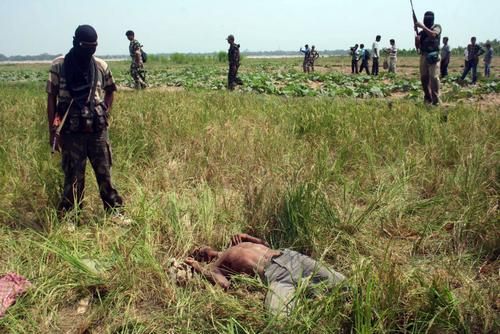Indian forces kill top Maoist leader
Indian paramilitary soldiers watch over the body of a suspected Maoist after an encounter at the village Bandarboni, close to Lalgarh on September 25, 2010. Indian media reported late Thursday that government forces had slain one of the Maoists’ top leaders, Kishenji, in West Bengal.
Indian paramilitary forces killed a top leader of a simmering Maoist rebellion against the government on Thursday, dealing a severe blow to an insurgency that the prime minister has called the greatest security threat to the country.
The leader, known as Kishenji, was killed in the jungles of West Bengal after a fierce firefight, according to the Times of India. Paramilitary soldiers of the Central Reserve Police Force, state police and commandos expended more than 1000 rounds of ammunition over a battle that lasted nearly two hours, the paper said.
When the shooting suddenly stopped, they advanced to find Kishenji dead, his AK-47 beside him in the dirt.
According to India’s Hindu newspaper, Kishenji’s killing marks a significant victory for the government, as he was one of the few Maoist leaders to possess ideological savvy and charisma along with a knack for guerrilla warfare.
Kishenji is credited with building the Lalgarh movement in West Bengal – one of the Maoists’ biggest successes of recent years – and he “ left an indelible imprint in building the revolutionary movement not just in West Bengal, but also in Andhra Pradesh and Dandakaranya (part of which is Chhattisgarh),” the paper said.
